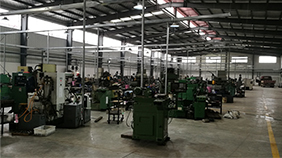industrial lockstitch machine
The Industrial Lockstitch Machine A Cornerstone of Modern Textile Production
The industrial lockstitch machine is a fundamental piece of equipment in the textile manufacturing industry. Renowned for its reliability, speed, and efficiency, this machine has become a crucial component in the production line of garments, upholstery, and numerous other fabric-based products. Understanding its operation, significance, and advancements over the years unveils the pivotal role it plays in modern manufacturing.
What is a Lockstitch Machine?
At its core, a lockstitch machine is designed to create a stitch by interlocking two threads the upper thread and the lower thread (or bobbin thread). This interlocking is achieved through a precisely timed needle and a bobbin mechanism, resulting in a stitch that is both strong and durable. The lockstitch is the most common type of stitch used in sewing due to its versatility and strength, making it ideal for various fabrics from delicate silks to heavy denim.
The Mechanism of Operation
The operation of an industrial lockstitch machine involves several key components, including the needle, presser foot, feed dogs, and the bobbin case. When the needle punctures the fabric, it pulls the upper thread down, which is then caught by the hook as it rotates. Simultaneously, the feed dogs move the fabric forward, allowing for consistent and even stitches. This mechanism works at high speeds—often exceeding 5,000 stitches per minute—making it suitable for large-scale production.
Additionally, modern lockstitch machines are equipped with automated features such as thread trimming, backstitching, and even automatic needle positioning to enhance productivity and reduce manual labor. These advancements not only streamline the sewing process but also increase the quality of the finished product.
Importance in the Textile Industry
The importance of the industrial lockstitch machine in the textile industry cannot be overstated. It is critical for a wide array of applications, including the production of clothing, linens, and other fabric goods. The machine significantly enhances production efficiency, allowing manufacturers to meet high demand while maintaining quality. Its ability to produce consistent and durable stitches is essential, especially in items subject to stress and tension, such as workwear and outdoor gear.
industrial lockstitch machine

Moreover, the lockstitch machine contributes to cost efficiency by minimizing fabric waste and reducing the time needed for sewing. As a result, businesses can maximize their output while minimizing overhead costs, leading to higher profit margins.
Innovations and Trends
As technology advances, the industrial lockstitch machine continues to evolve. Recent innovations include computerized models that offer programmable sewing patterns, which can be especially beneficial for manufacturers producing diverse products. These automated systems enable quick adjustments to sewing parameters, enhancing flexibility and responsiveness to market demands.
Furthermore, eco-friendly initiatives are influencing the design of new machines. Manufacturers are increasingly focused on creating energy-efficient models that reduce carbon footprints and incorporate sustainable materials. These developments reflect a broader industry trend towards sustainability and environmental responsibility.
Challenges and Future Directions
Despite its many advantages, the industrial lockstitch machine faces challenges. One of the primary concerns is the skilled labor shortage within the garment industry. As technology becomes more specialized, there is a growing need for trained operators who can not only run these machines but also troubleshoot and maintain them.
Looking ahead, the integration of artificial intelligence and machine learning into lockstitch machines could be a game-changer. These technologies could enhance predictive maintenance, minimize downtime, and further optimize production processes, leading to even greater efficiency.
Conclusion
In conclusion, the industrial lockstitch machine is a vital instrument in the textile manufacturing sector, combining speed, durability, and efficiency. As the industry continues to evolve, so too will the capabilities of these machines, adapting to new challenges and integrating innovative technologies. Understanding and embracing these changes will be crucial for manufacturers aiming to stay competitive in an ever-changing market. The industrial lockstitch machine not only stitches fabric together but also weaves the very fabric of the modern textile industry.
-
Industrial Cylinder Arm Sewing Machine: Revolutionizing Heavy-Duty SewingNewsJul.28,2025
-
Cylinder Arm Sewing Machine: Perfect for Special Sewing ApplicationsNewsJul.28,2025
-
Cylinder Bed Sewing Machine: Essential for Sewing Complex MaterialsNewsJul.28,2025
-
Heavy Duty Sewing Machine: The Essential Tool for Industrial ApplicationsNewsJul.28,2025
-
Computerized Pattern Sewing Machine: Revolutionizing Precision StitchingNewsJul.28,2025
-
Heavy Duty Industrial Sewing Machine: Power Meets PrecisionNewsJul.28,2025
-
Leather Sewing Machine: The Industrial Standard for Tough MaterialsNewsJul.18,2025





























